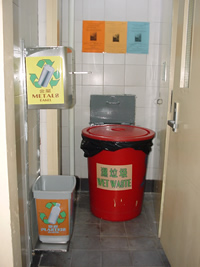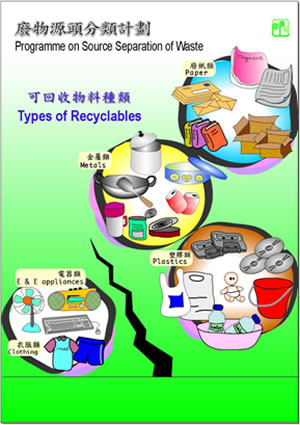 Background Background |
In 2004, about 6.41 million tonnes of wastes were disposed of in our three landfills. It is projected that the existing landfills would only last 6 to 10 years if waste continues to grow at the current trend. Waste reduction and recycling is therefore crucial in minimising the amount of waste requiring disposal.
In recent years Government has been testing out various forms of domestic waste separation and recovery with a view to identifying the modes that are convenient to residents, cost-effective and best suit local needs. It is recognized that there may be different modes for different types of buildings in Hong Kong.
3-Coloured Waste Separation Bin System
Since the launch of the Waste Reduction Framework Plan in 1998, Government has been promoting waste reduction and recycling through the use of 3-coloured waste separation bins placed at housing estates for collection of paper, aluminium cans and plastic bottles. The 3-coloured-bin concept has been well received by the public. The bins are now placed in about 1,400 housing estates in the territory, covering about 70% of the population.
610,000 tonnes of paper, 21,000 tonnes of aluminium cans, and 5,000 tonnes of plastic bottles have been recovered since 1998, amounting to a total market value of $530 million and saved landfill cost of $80 million.
Pilot Programme on Dry and Wet Waste Separation
We conducted a 12-month pilot programme on separating dry and wet wastes in 4 housing estates in the Eastern District in March 2003. The amount of recyclables collected from these 4 housing estates was 12% more than the territory-average of housing estates using the 3-coloured waste separation bin system only. The total amount of plastic waste collected was increased rigorously by 250%. Despite the impressive results, this scheme is not sustainable as the net processing cost is high.
 Details of Programme on Source Separation of Domestic Waste Details of Programme on Source Separation of Domestic Waste |
Making waste separation more convenient
In order to make it more convenient for residents to separate waste, a 12-month Pilot Programme on Source Separation of Domestic Waste has been launched in 13 housing estates in the Eastern District (covering 37,000 households and a population of 120,000) since August 2004.
The objective of the programme is to facilitate residents to separate waste at source by encouraging and assisting property management companies to provide waste separation facilities on each building floor, and broaden the types of recyclables to be recovered. All residents need to do is to separate recyclables in the waste by category, such as waste paper, metals and plastics, and then take them to designated locations on each floor.
'Tailor-made' for each estate
 |
|
In Lei King Wan, residents stack waste paper on the wall-mounted shelf in the refuse room on each floor, and put metals and plastics in designated collection containers. |
Each participating housing estate will adopt the best mode of waste separation and recovery tailor-made to suit its particular physical constraints and other characteristics, by setting up appropriate waste separation facilities on each floor.
For example, wall-mounted shelf can be used for collecting waste paper, and separate bins for metals and plastics; bins with compartments can be used to separate wastes; or different types of recyclables can be collected on different days of the week, say, metals may be collected on Mondays, Wednesdays and Fridays, while plastics on Tuesdays, Thursdays and Saturdays. Different buildings can choose whatever modes best suit their needs. The main point is to provide a convenient way for residents to separate recyclables for cleansing workers to collect so as to increase the quantity of recyclables recovered.
Recyclables can be separated within each estate and sold directly to recyclers, and management companies or cleansing contractors will be able to pass on to residents the benefits of the extra income.
Expanded scope of recyclables recovered
Besides paper, aluminium cans and plastic bottles that are currently collected by the 3-coloured waste separation bins, the types of recyclables recovered will be broadened to include other types of recyclables like:
-
Other metal cans (e.g. biscuit tins, clean food cans)
-
Mixed metal items (e.g. pots, vacuum flasks)
-
Plastic bags (e.g. shopping bags, packaging)
-
Mixed plastics (e.g. CDs, toys)

Periodic programmes for collection of specific types of reusable/recyclable materials
Each participating housing estate can run periodic large scale collection programmes for specific types of reusable/recyclable materials such as clothing, electronic and electrical appliances and computers for resale to recyclers.
The Social Welfare Department also organizes a programme called "Social Recycling Programme" which is coordinated by its Marketing Consultancy Office (Rehabilitation) to collect reusable/recyclable materials from housing estates to sheltered workshops for cleaning, repairing and re-packaging. These reusable/recyclable materials will later be arranged for sale at retail shops of rehabilitation organizations or the open market. For details, please call the Marketing Consultancy Office (Rehabilitation) of the Social Welfare Department at 2835 2146.
Encouraging results
The initial results of the pilot programme were encouraging. Some of the participating housing estates more than doubled the quantity of recovered recyclables. The programme has also brought additional income. In the case of Heng Fa Chuen, the sale of recyclables brought an income of more than $100,000 to its property management company in 2004, net of the income to the cleaners. The revenue may not be very much, but it surely provides the housing estates and their residents with extra benefits from the additional income.
Territory-wide roll out
In view of the encouraging results of the pilot programme, a territory-wide programme to implement Source Separation of Domestic Waste has been rolled out since January 2005.
Up to now over 150 housing estates/buildings have joined the programme. If your housing estate/building has not yet joined the programme, Please Act Now!

|
|
Dorothy demonstrates the proper way to separate waste at source. |
How to Join?
If you would like to join the Programme on Source Separation of Domestic Waste, please approach the Management Company/Incorporated Owners' Committee/Owners' Committee of your housing estate/building, and request them to participate by following the steps below:
Step 1: Submit Application
Step 2: ' Tailor-made ' Waste Separation Mode
Step 3: Set Up Waste Separation Facilities
Step 3a: Need Funding Support?
Step 4: Educate Residents
Step 5: Collect Recyclables
Step 6: Submit Monthly Record
Enquiry Hotline
Step 1: Submit Application
Complete and fax the Application Form  and Undertaking and Undertaking  to the Waste Reduction Group of EPD (Fax No.:2872 0389). to the Waste Reduction Group of EPD (Fax No.:2872 0389).
|

|
Step 2: ' Tailor-made ' Waste Separation Mode
According to the physical settings and characteristics of your building (e.g. whether there is a refuse room on each floor), 'tailor-made' the most suitable waste separation mode. You may refer to the Preliminary Guideline on Source Separation of Waste in Residential Buildings  . It advises you on the feasible waste separation modes that can be practiced in different possible locations on each building floor. A comprehensive Guidebook will be available later in 2005. . It advises you on the feasible waste separation modes that can be practiced in different possible locations on each building floor. A comprehensive Guidebook will be available later in 2005.
|


|
Step 3a: Need Funding Support?
If your housing estate/building needs funding support for the procurement and installation of waste separation facilities on each building floor, you can apply for the Environment and Conservation Fund (ECF) (Application form)  for partial support to the set-up cost. A limit of 25% of the total actual expenditure spent for the approved waste separation facilities on each building floor will be reimbursed subject to a maximum of $150,000 per estate. Please refer to the Guide to Application for partial support to the set-up cost. A limit of 25% of the total actual expenditure spent for the approved waste separation facilities on each building floor will be reimbursed subject to a maximum of $150,000 per estate. Please refer to the Guide to Application  for detailed guidance on application procedure. The Guide describes the basic requirements and responsibilities for the recipient organization. for detailed guidance on application procedure. The Guide describes the basic requirements and responsibilities for the recipient organization.
Upon approval of the Fund, housing estate/building should install the waste separation facilities. After completion of installation, you should complete a Noticification Form  and submit it to Waste Reduction Group of EPD (Fax No.:2872 0389). Disbursement will then be paid to the housing estate/building. and submit it to Waste Reduction Group of EPD (Fax No.:2872 0389). Disbursement will then be paid to the housing estate/building.
|

|
Step 4: Educate Residents
Organize education and promotion activities at your housing estate/building to encourage residents to participate.
You are encouraged to design and produce your own publicity materials that can educate residents about the 'tailor-made' waste separation mode of your housing estate/building.
For standard publicity materials and other education and promotion support, please contact the Waste Reduction Group of EPD (Tel: 2872 1724).
You may also download electronic copies of the standard Poster and Leaflet  here. here.
|


|
Step 6: Submit Monthly Record
Submit the Monthly Record Sheet  on the quantities of paper, metals, plastics and other recyclables collected to the Waste Reduction Group of EPD (Fax No.:2872 0389) within the first week of each following month. on the quantities of paper, metals, plastics and other recyclables collected to the Waste Reduction Group of EPD (Fax No.:2872 0389) within the first week of each following month.
You should keep a record of the baseline waste data of your housing estate/building (including monthly quantities of recyclables collected, and daily number of bins of refuse) prior to commencement of the programme, so that you can track your the effectiveness of your programme.
To encourage active participation by residents, each housing estate/building that has signed up to join the programme is automatically entered into a waste recycling competition under the programme. Winning housing estates/buildings will be invited to an award presentation ceremony. For more information, please refer to the Competition Details.
|
For enquiry, please dial the EPD Hotline at 2838 3111.
 ECF Fund Now Available for Application ECF Fund Now Available for Application |
To encourage more housing estates / residential buildings to participate in the Programme on Source Separation of Domestic Waste, the Environment and Conservation Fund (ECF) is now open for residents' organizations and property management companies to apply for funding support to implement the programme. A sum of $5 million has been allocated by the ECF Committee for this purpose.
Incorporated owners' committees, owners' committees or any residents' organizations of private housing estates / residential buildings are eligible to apply for the Fund. Property management companies acting on behalf of the residents' organizations of the private housing estates / residential buildings are also eligible for submission of applications. Funds will be granted for partial support to the set-up cost of the programme. A limit of 25% of the total actual expenditure spent on the approved waste separation facilities on each building floor will be reimbursed subject to a maximum of $150,000 per estate.
Applicants should complete the Application Form and return to the Environmental Protection Department during the 3-month application period starting from 1 August 2005 to 31 October 2005. Completed applications will be processed on a first come first served basis until the allocated amount of $5 million is exhausted or the application period has lapsed.
Anyone who is interested in the funding scheme, please refer to our newly released Guide to Application for detailed application procedure or call 2872 1724 for more information about the scheme.
|